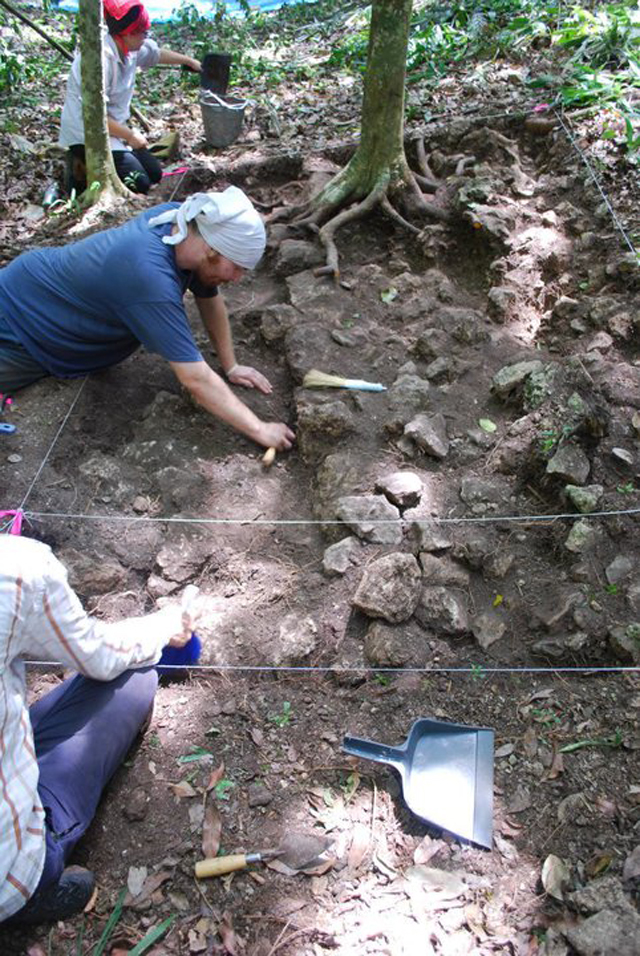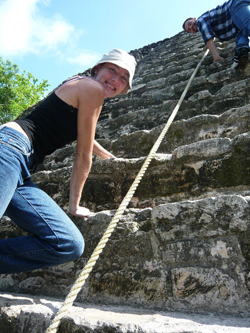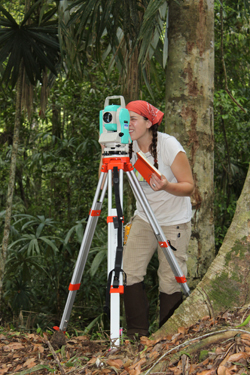
Seniors Bal and Willer will return to the site of an ancient Mayan temple and a network of caves beneath it. They uncovered them a year ago while attending the Belize Archaeology Field School in the northwest part of the country. Marisol Cortes-Rincon of HSU's Department of Anthropology is currently recruiting students for the 2011 summer session with Bal, Willer and some 15-20 other Humboldt State students.
Last year, surveying a transect that begins at the ancient site of Dos Hombres, Bal, Willer and fellow HSU undergrads tracked down the temple's limestone remains, which probably date to 250-900 A.D. They also found indications of a system of caves beneath the structure and water management features. The Maya believed caves and water were means to connect to the underworld.
If Bal and Willer's surmise about artifact preservation within caves proves correct, they may turn up important archaeological finds when they return in May. "The preservation is exceptional because caves are dryer and will preserve cultural material better," Willer said.
As for the temple, the students pinpointed the remains on the top of a knoll, surrounded by many smaller structures. They estimate the largest building's dimensions at 20 meters long and 8 meters high. "We took hundreds of pictures and planted flags around the area to measure it," Bal recounted.

This summer they plan to remove a great deal of debris from the caves, probe for cultural and biological remains inside and, if time permits, map the interiors.
"We also hope to explore further along the transect because there may be a lot out there we don't even know about yet," Bal enthused. "I love the surveying and exploring."
HSU geography major Jamie Baxter also attended last summer’s field school, helping to map ancient Maya architecture with a total mapping station. She will present her findings at the annual meeting of the Society for American Archaeology, starting March 31. Cortes-Rincon will join her with a presentation on Maya settlement patterns.
The Belize Archaeology Field School provides HSU undergraduates with hands-on experiences through surveys and excavations at three Maya sites—Dos Hombres, Gran Cacao and Great Savannah—where ancient ruins are found. Students learn how archaeologists draw inferences about human behavior and practices from patterns in the distribution, form and context of material remains. They also pick up valuable laboratory experience working directly on excavated Maya artifacts.

The curriculum combines instruction in field techniques with lectures by Cortes-Rincon in cultural history and artifact analysis. Many of the Belize lectures are presented in the field. Students spend eight hours in the jungle, Sunday to Friday.
"Everything Shannon, Safiya and Jamie are learning in the classroom they're applying right there in Belize," Cortes-Rincon said. "And they are pioneers: no one has seen before the area along that transect."
Cortes-Rincon started as a volunteer in the Belize project while she was an undergraduate at Montclair State University, New Jersey. She earned her doctorate at the University of Texas, Austin. She considers the Belize project an excellent stepping stone for students aspiring to a career in anthropology and archaeology. It was Cortes-Rincon who inaugurated Humboldt State's involvement in Belize a year ago.
The Belize Archaeological Field School offers a unique educational opportunity, in Cortes-Rincon’s view. "Because we share the camp with other schools, we have contact with other researchers and specialists, and we all learn from each other. If we find a burial, for example, we can call in the forensic archaeologist, Lauri Martin. She's in camp with us, and she'll come over and excavate it. Last summer we had an ecology specialist, Nick Brokav, with us, and there are also soil specialists."
Students network with these experts and with sister universities, pooling resources and professional contacts as well as academic knowledge. "That's the beauty of the Belize project," Cortes-Rincon said. "Students interact with so many different people away from campus, and they enjoy intercultural exchanges at the personal level along with the academic one."
Field experience is a major advantage in job hunting. Cortes-Rincon explained: "Safiya is thinking about going into cultural resource management, and CRM requires field school experience. So she can add the Belize background to her resume. When I hire, I always look for field experience, it's essential."
While studying Belize's ancient life, students learn about the nation's contemporary life and its remarkable diversity. "I was a bit surprised by the contemporary culture of Belize," Will said. "The camp is about a 20 minute drive from a Mennonite community. We got to spend a day a week at their community store, talking with Mennonites. Here were these blond, blue-eyed residents speaking Mayan, Spanish and English as well as German—quadralingual!"
Applications are due in mid-March for the May 19-June 16 field school. Dr. Cortes-Rincon can be reached at 826-4335 and mc479@humboldt.edu.